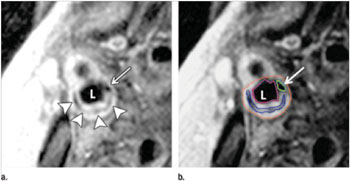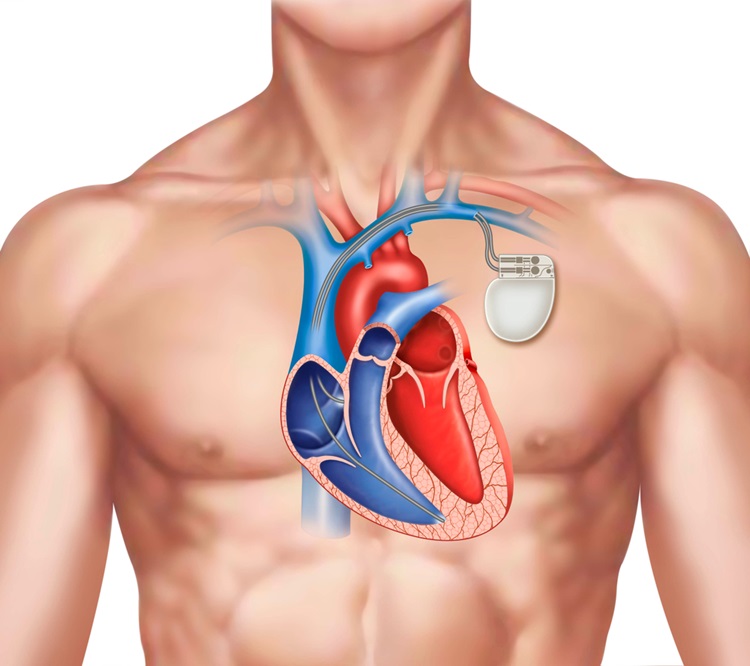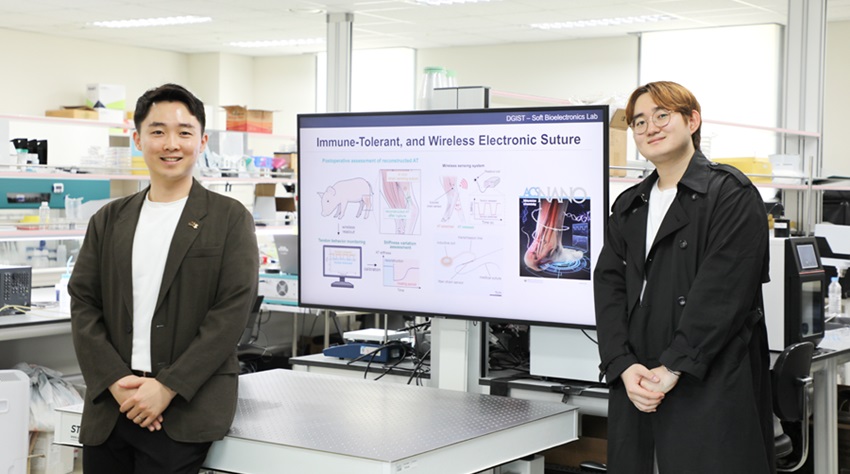Carotid Artery MRI May Predict Probability of Heart Attack, Stroke
|
By HospiMedica International staff writers Posted on 17 Mar 2014 |

Image: Transverse (a) T2-weighted, (b) unenhanced T1-weighted, and (c) gadolinium-enhanced T1-weighted MR images in an 82-year-old man. The left ICA wall shows no plaque or significant wall thickening. The right ICA shows plaque with a lipid core (arrow). ICA = internal carotid artery, ECA = external carotid artery, IJ = internal jugular vein (Photo courtesy of the Radiological Society of North America).

Image: Transverse gadolinium-enhanced T1-weighted MR images obtained superior to the carotid artery bifurcation in a 72-year-old man. L = ICA (internal carotid artery) lumen. (a) Low-signal-intensity calcium (arrow) and lipid core (arrowheads) can be seen. (b) Note contouring of the ICA. The outer adventitial wall (red), lipid core (blue), calcification (green), and vessel lumen (purple) are visible (Photo courtesy of the Radiological Society of North America).
Noninvasive magnetic resonance imaging (MRI) of carotid artery plaque can effectively forecast future cardiovascular events such as strokes and heart attacks in individuals without a history of cardiovascular disease, according to a new research.
Researchers have long known that some arterial plaque is more dangerous because of its vulnerability to rupture. MRI can distinguish facets of vulnerable plaque, such as a lipid core with a thin fibrous cap. This ability makes MRI a potentially valuable tool for identifying patients at risk for ensuing cardiovascular events.
To study the predictive benefits of MRI plaque imaging, researchers performed carotid artery ultrasound and MRI on 946 asymptomatic patients from the Multi-Ethnic Study of Atherosclerosis (MESA). The carotid arteries are very accessible for imaging, and their condition tends to reflect that of the coronary arteries that supply the heart with oxygenated blood.
The researchers, who published their findings online March 2014 in the journal Radiology, used ultrasound to evaluate carotid wall thickness and MRI to define carotid plaque composition and the remodeling index, a gauge of changes in vessel size. Imaging findings were compared with cardiovascular events, including heart attacks, stroke, and death, for an average of 5.5 years after examination.
“We studied asymptomatic individuals with a low risk of cardiovascular events at baseline and used noninvasive imaging to predict the risk of an event downstream,” said David A. Bluemke, MD, PhD, from the US National Institutes of Health Clinical Center (Bethesda, MD, USA). “This is the first population-based prospective study to determine if vulnerable plaque features by MRI add to the risk of a cardiovascular event beyond the traditional risk factors.”
Cardiovascular events occurred in 59 of the patients. Abnormal thickening of the carotid artery wall and the presence of a lipid core and calcium in the internal carotid artery on MRI were significant predictors of subsequent events. A lipid core was present in nearly half of the patients who had an event, compared with only 17.8% of those who did not have an event. “The primary factors that predicted future risk were measures of vessel wall thickness in combination with the presence or absence of a lipid core,” Dr. Bluemke said. “The presence of a lipid core was 50% more common in people who had subsequent events.”
Using MRI scanning improved the reclassification of baseline cardiovascular risk in the study group. When both the carotid remodeling index and lipid core were used for risk stratification, approximately 16% more patients with events and 7% without events were accurately reclassified compared with the use of traditional risk factors. “The results bolster the use of MRI as a surrogate marker of efficacy in therapeutic studies and point to a role in determining which patients might need more aggressive treatments,” Dr. Bluemke said. “As risk factor prediction gets better, we’ll be able to screen more intelligently and use more intensive treatments in those individuals who face a higher risk of cardiovascular events.”
Dr. Bluemke noted that sequences for plaque composition could be readily added to existing carotid MRI angiography protocols for clinical purposes. “Carotid MRI has significant advantages,” he stated. “The results are more reproducible than those of ultrasound.”
Dr. Bluemke emphasized that the availability and cost-effectiveness could restrict the use of MRI. However, ultrasound and computed tomography (CT) are practical options for screening, he noted, particularly with improvements in CT dose reduction.
Related Links:
US National Institutes of Health Clinical Center
Researchers have long known that some arterial plaque is more dangerous because of its vulnerability to rupture. MRI can distinguish facets of vulnerable plaque, such as a lipid core with a thin fibrous cap. This ability makes MRI a potentially valuable tool for identifying patients at risk for ensuing cardiovascular events.
To study the predictive benefits of MRI plaque imaging, researchers performed carotid artery ultrasound and MRI on 946 asymptomatic patients from the Multi-Ethnic Study of Atherosclerosis (MESA). The carotid arteries are very accessible for imaging, and their condition tends to reflect that of the coronary arteries that supply the heart with oxygenated blood.
The researchers, who published their findings online March 2014 in the journal Radiology, used ultrasound to evaluate carotid wall thickness and MRI to define carotid plaque composition and the remodeling index, a gauge of changes in vessel size. Imaging findings were compared with cardiovascular events, including heart attacks, stroke, and death, for an average of 5.5 years after examination.
“We studied asymptomatic individuals with a low risk of cardiovascular events at baseline and used noninvasive imaging to predict the risk of an event downstream,” said David A. Bluemke, MD, PhD, from the US National Institutes of Health Clinical Center (Bethesda, MD, USA). “This is the first population-based prospective study to determine if vulnerable plaque features by MRI add to the risk of a cardiovascular event beyond the traditional risk factors.”
Cardiovascular events occurred in 59 of the patients. Abnormal thickening of the carotid artery wall and the presence of a lipid core and calcium in the internal carotid artery on MRI were significant predictors of subsequent events. A lipid core was present in nearly half of the patients who had an event, compared with only 17.8% of those who did not have an event. “The primary factors that predicted future risk were measures of vessel wall thickness in combination with the presence or absence of a lipid core,” Dr. Bluemke said. “The presence of a lipid core was 50% more common in people who had subsequent events.”
Using MRI scanning improved the reclassification of baseline cardiovascular risk in the study group. When both the carotid remodeling index and lipid core were used for risk stratification, approximately 16% more patients with events and 7% without events were accurately reclassified compared with the use of traditional risk factors. “The results bolster the use of MRI as a surrogate marker of efficacy in therapeutic studies and point to a role in determining which patients might need more aggressive treatments,” Dr. Bluemke said. “As risk factor prediction gets better, we’ll be able to screen more intelligently and use more intensive treatments in those individuals who face a higher risk of cardiovascular events.”
Dr. Bluemke noted that sequences for plaque composition could be readily added to existing carotid MRI angiography protocols for clinical purposes. “Carotid MRI has significant advantages,” he stated. “The results are more reproducible than those of ultrasound.”
Dr. Bluemke emphasized that the availability and cost-effectiveness could restrict the use of MRI. However, ultrasound and computed tomography (CT) are practical options for screening, he noted, particularly with improvements in CT dose reduction.
Related Links:
US National Institutes of Health Clinical Center
Latest Critical Care News
- WHO Publishes First Global Guidelines to Reduce Bloodstream Infections from Catheter Use
- Innovative Material Paves Way for Next-Generation Wearable Devices
- Wireless Electronic Suture Enables Postoperative Long-Term Monitoring Of Soft Tissue
- Transcatheter Valve Replacement Outcomes Similar To Surgery, Finds Study
- Revascularization Improves Life Quality in Chronic Limb-Threatening Ischemia, Finds Study
- Powerful AI Risk Assessment Tool Predicts Outcomes in Heart Failure Patients
- Peptide-Based Hydrogels Repair Damaged Organs and Tissues On-The-Spot
- One-Hour Endoscopic Procedure Could Eliminate Need for Insulin for Type 2 Diabetes
- AI Can Prioritize Emergency Department Patients Requiring Urgent Treatment
- AI to Improve Diagnosis of Atrial Fibrillation
- Stretchable Microneedles to Help In Accurate Tracking of Abnormalities and Identifying Rapid Treatment
- Machine Learning Tool Identifies Rare, Undiagnosed Immune Disorders from Patient EHRs
- On-Skin Wearable Bioelectronic Device Paves Way for Intelligent Implants
- First-Of-Its-Kind Dissolvable Stent to Improve Outcomes for Patients with Severe PAD
- AI Brain-Age Estimation Technology Uses EEG Scans to Screen for Degenerative Diseases
- Wheeze-Counting Wearable Device Monitors Patient's Breathing In Real Time
Channels
Artificial Intelligence
view channel
AI-Powered Algorithm to Revolutionize Detection of Atrial Fibrillation
Atrial fibrillation (AFib), a condition characterized by an irregular and often rapid heart rate, is linked to increased risks of stroke and heart failure. This is because the irregular heartbeat in AFib... Read more
AI Diagnostic Tool Accurately Detects Valvular Disorders Often Missed by Doctors
Doctors generally use stethoscopes to listen for the characteristic lub-dub sounds made by heart valves opening and closing. They also listen for less prominent sounds that indicate problems with these valves.... Read moreCritical Care
view channel
WHO Publishes First Global Guidelines to Reduce Bloodstream Infections from Catheter Use
Up to 70% of all inpatients require a catheter, specifically a peripherally inserted catheter (PIVC), at some point during their hospital stay. Patients who receive treatments via catheters are particularly... Read moreInnovative Material Paves Way for Next-Generation Wearable Devices
Wireless modules that integrate telecommunications and power-harvesting capabilities, powered by radio-frequency (RF) electronics, are crucial for advancing skin-interfaced stretchable electronics.... Read moreSurgical Techniques
view channel
New Adhesive Hydrogel Coatings to Prolong Lifespan of Pacemakers and Medical Implants
When medical devices such as pacemakers are implanted in the body, they often trigger an immune response that results in the accumulation of scar tissue around the device. This scarring, known as fibrosis,... Read more
Maneuvering System Empowers Surgeons with Enhanced Control during Laparoscopic Procedures
Minimally invasive surgery (MIS) techniques have transformed patient care by providing less invasive options compared to traditional open surgeries. These methods often involve smaller cuts, less tissue... Read more
New Two-Dimensional Material Paves Way for Safer, More Effective Implantable Medical Devices
Borophene, first synthesized in 2015, is an atomically thin version of boron that surpasses graphene—the two-dimensional (2D) version of carbon—in conductivity, thinness, lightness, strength, and flexibility.... Read morePatient Care
view channelFirst-Of-Its-Kind Portable Germicidal Light Technology Disinfects High-Touch Clinical Surfaces in Seconds
Reducing healthcare-acquired infections (HAIs) remains a pressing issue within global healthcare systems. In the United States alone, 1.7 million patients contract HAIs annually, leading to approximately... Read more
Surgical Capacity Optimization Solution Helps Hospitals Boost OR Utilization
An innovative solution has the capability to transform surgical capacity utilization by targeting the root cause of surgical block time inefficiencies. Fujitsu Limited’s (Tokyo, Japan) Surgical Capacity... Read more
Game-Changing Innovation in Surgical Instrument Sterilization Significantly Improves OR Throughput
A groundbreaking innovation enables hospitals to significantly improve instrument processing time and throughput in operating rooms (ORs) and sterile processing departments. Turbett Surgical, Inc.... Read moreHealth IT
view channel
Machine Learning Model Improves Mortality Risk Prediction for Cardiac Surgery Patients
Machine learning algorithms have been deployed to create predictive models in various medical fields, with some demonstrating improved outcomes compared to their standard-of-care counterparts.... Read more
Strategic Collaboration to Develop and Integrate Generative AI into Healthcare
Top industry experts have underscored the immediate requirement for healthcare systems and hospitals to respond to severe cost and margin pressures. Close to half of U.S. hospitals ended 2022 in the red... Read more
AI-Enabled Operating Rooms Solution Helps Hospitals Maximize Utilization and Unlock Capacity
For healthcare organizations, optimizing operating room (OR) utilization during prime time hours is a complex challenge. Surgeons and clinics face difficulties in finding available slots for booking cases,... Read more
AI Predicts Pancreatic Cancer Three Years before Diagnosis from Patients’ Medical Records
Screening for common cancers like breast, cervix, and prostate cancer relies on relatively simple and highly effective techniques, such as mammograms, Pap smears, and blood tests. These methods have revolutionized... Read morePoint of Care
view channel
Cartridge-Based Hemostasis Analyzer System Enables Faster Coagulation Testing
Quickly assessing a patient's total hemostasis status can be critical to influencing clinical outcomes and using blood products. Haemonetics Corporation (Boston, MA, USA) has now obtained 510(k) clearance... Read more
Critical Bleeding Management System to Help Hospitals Further Standardize Viscoelastic Testing
Surgical procedures are often accompanied by significant blood loss and the subsequent high likelihood of the need for allogeneic blood transfusions. These transfusions, while critical, are linked to various... Read moreBusiness
view channel
Johnson & Johnson Acquires Cardiovascular Medical Device Company Shockwave Medical
Johnson & Johnson (New Brunswick, N.J., USA) and Shockwave Medical (Santa Clara, CA, USA) have entered into a definitive agreement under which Johnson & Johnson will acquire all of Shockwave’s... Read more














.jpeg)
_1.jpg)



